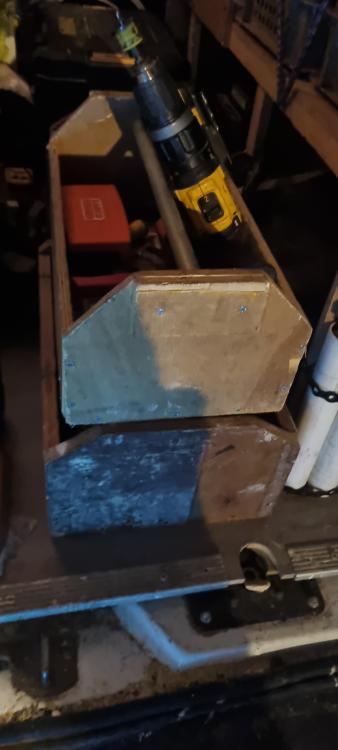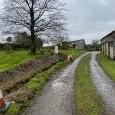Leaderboard
Popular Content
Showing content with the highest reputation on 12/16/23 in all areas
-
MVHR: ensure the intake and exhaust are on the same face of the building so they are exposed to even wind pressure.2 points
-
I still have my “tin” one like above, it’s only 51 years old 🤣 but when full of spanner’s very heavy. I have two “tote” type bags, big one like you posted for bigger stuff and a small one for smaller tools, fits the bill for me 👍2 points
-
That's a nasty number! Ok this seems a bit back to front but bear with me. It's a bit of a long read but hopefully you can pick out some bits that help you. You know what you want to build, how big it is as you have the plans. Do you know how you are going to build it? What are you preferred founds? What's the Architect's / your thoughts - strip founds, raft etc? From what you have we can make a quick approximation of the load the house is going to apply to the ground and how.. raft.. low pressure, strip founds a bit higher etc. Next is to go back to the beginning and find out exactly what the planners are asking for (you need to be reasonably confident you'll get planning in the bag before splashing too much cash) and really look closely at the level of information they actually require. On the plus side here there seems to be pattern for your local area.. the planning computer says no unless we can tick the boxes. You may be able access other reports for the area to see what approach does work and then how you tweak that suit you best. Now we look at what we need to know to build the thing in terms of geotechnical information. We have a mining element, will come to that later. Also potential gas from land fill and associated with that is contamination of the ground water. We would also check for Radon as a matter of course. The gas from the landfill. Risks are.. it forms pockets of gas under your house, explodes and blows your house up, asphxiates you in bed or gives you sick building syndrome (high mortgage rates can have the same effect) .. but the land topography and ground may make that impossible. Just because it is 500m on plan may not mean anything. Just say you have a railway cutting or other topographic barrier between you and the land fill.. how is the gas going to get to your house? If you can identify something like this and make a reasoned arguement then no need for gas monitoring? Gas monitoring is tricky to install and needs "monitoring" = cost thus we want to avoid if at all reasonably justifiable. The ground water contamination carries risk. Just say you have some to make a good story! Clearly we need to keep any contamination away from people and animals but also certain types of contamination will drive the selection of the type, grade of concrete and steel reinforcement cover if we are reinforcing the founds. Things like sulphate content, acidity and mobilty of the ground water can drive the concrete design and this would be associated with contamination at a shallow depth. Also, if you have a public water supply the supply pipework needs to be able to resist contaminated water (comes at a cost), and if you are going for a private water supply... well you really do want to know about contamination. I find the mining fascinating. I've done some jobs where we have bored for mine shafts and shallow workings on small sites where the Client was happy to fork out the cash.. the outcome was that we never found many of them.. but that is not to say they weren't there.. all I learnt was they were not where we drilled! I was convinced they were there at times on some sites but unless you absolutely pepper the place you can't be sure. In the round I often made the argument that on balance of probablity there was not a huge void under the structure, made some assumptions about the type and size of void that could reasonably be there and designed the founds for that. The mining. Now on the above we didn't just turn up on the day with a drilling rig. I carried out a really comprehensive (phase one) desk top study and spent at least a day walking over the site, the surrounding area, looking at the trees, the topography of the ground, and chatting to local folk.. who are often really helpful and sometimes will show you old photos they and their family have kept. Next is re examine the mining records (can be hard) and public available borehole records. I try and find any historic books on the area that maybe relate to industrial activity, old geological records. Sometimes you find nothing at all and sometimes you find a nugget of information that can save you thousands. Now you can imagine that I'm not going to do this for free! but there is good reason for this approach, it makes you think and by doing that you manage risk. All of the above gets coupled up with a typical search (historic maps, floor risk area, general mining risk etc) and info from say Ground Sure or other companies that provide these types of online data services. But the value lies in showing (and just knowing in your own mind) that you have followed the correct procedure in terms of identifying risk, what you do know, what you don't, there is the "what we don't know we don't know".. but life is exciting enough as it is. The objective of this is two fold. It allows me to make a list of all the things that need to be considered, then apportion risk and prioritise each of them. It also lets me plan the intrusive (investgative part) of the site investigation and make best use of the funds available to do that. The funds can vary depending on how much the Client is risk averse.. some Clients just don't listen enough to make their own informed decisions and regret later. To come back to the mining risk. As a quick over view there are a few different types of shallow mines you can encounter. Don't forget that more modern mines had ventilation and escape / ventilation shafts. Early mining acts for example 1862 prohibited single shaft mines. As a quick run down. From early times folk just dug up coal where it outcropped from the ground. Then you had say the Monks that dug bell pits, 12th centuary onwards. Ok a lot of these these have probably collapsed / settled a good bit but there are a few examples localish to me where you can see the depression in the ground from collapsed bell pits.. not for building on at sensible cost. Mind you, I have often wondered if I'll find someone who wants to dig it back out and make a bell pit basement. Jumping ahead you had drift mining.. they dug from ground level and followed the coal seam which is usually sloping. Later these were widened using say timber props, you have the pillar and stall method where they would leave pillars of coal, dig out the coal, chuck the spoil into the redundant bits and when they abandonded the mine they removed the pillars and let the thing fall down as they progresssivly left the mine. Laterally in some places they started using a method called long wall mining. Here they used a big machine to excavate the seam and just let it progressivly collapse behind them. This created a rolling wave of soil movement at the surface which damages houses. But the main thing here is this type of ground collapse happens quite quickly.. a few years, a couple of decades to settle in once the mine is fuly abandoned and the ground water recovers, which lubricates the particulates of soil, encouraging settlement. Older types of mining - some can take 100 years or more before they throw in the towel and cause problems at the surface. All the above relates to shallow mining in general. Deep coal mines tend to have many layers of rock over so the tiny extra bit of weight from a house is negligeable. Now the brief history story is nearly over. Next step is to try and identify where the coal is (if in Cornwall say then there is a lot of mineral mining but the same basic rules apply with a few tweaks), the way the rock and coal seams are sloping (they tend not to be flat and level and early miners followed the seams), how thick they may be.. and where the ground water lies. Now the good thing is that in a lot of the UK there is ground water extraction which tends to lower the water table. Many mines have been shut since the 1980's so the pumping has long ceased. Therefore the ground water level we see now is probably lower than what it was historically, give or take. This can give us the "worst case reasonable depth" of some types of mines. What kind of mining has possibly taken place in the past? If we can find a bit about the ground water average level then we could assume the Monks, earlier methods of pillar and stall were no deeper as they didn't have steam pumps say to get the water out. Many millions of years ago the part of the UK below the Highland boundary fault was well south of the equator before it joined up with the top part of Scotland to make the UK.. our island. There is more to it but for another day. The coal was laid down when the bottom part of the UK was tropical / sub tropical. Later though when we all got glued together the magma in the earth forced it's way up to create what we call magma (granite) intrusions / dykes. This hot material burnt the coal measures and these are often marked as "barren coal". In other words it's of little use. It is a wel known fact that barren coal measures were avoided by the miners. In places dykes can be quite closely spaced and are often identified in the records. Mind you you don't want one under half your house as they are nightmare to ecavate and cause hard spot which is problematic, not just for founds but getting drainage routes established.. Now if your site has say a high water table, some granite dykes then we want to look at that as we may be able to say.. hey this coal is barren / high water table so it probaly has not been mined... thus no need to indulge in expensive driling. Just be aware though. It's not just coal. In many parts of the UK they also mined fire clay and other minerals so we would need to watch out for that. All of the above is the phase one investigation, thinking and research. If you assume you are going to get planning approval in one form or another I would be inclined to plan the site investigation around gathering the information we really need to get the house built. I would try and avoid gas monitoring, drilling if possible (make a big saving) and spend a bit of the savings on maybe more trial pits, some porosity testing, gruond water (especially is you have a basement) to make sure you can get rid of the water easily. On the other hand if it turns out you do have a real mining / contamination issue then we need to know that as soon as possible so we can design for it at the outset and manage cost. It may be worth doing both phase one and two (intrusive investigation/ analysis) at the same time. Then tailor a report with plenty technical detail for the planning submission. Say to the planners, if there is anything you disagree with let us know. At the end of the day if we are going to design the structure to be safe and seviceable then surely that should satisfy the planners? I think the planners want to know that what they are giving concent for is not going to create a legacy problem. In some ways you are just a custodian of the house. Hope this helps a bit, keep us updated and all the best.2 points
-
We hired a spray pump from Screwfix on our previous build Which worked ok Probably a bit to industrial for a single house This time round I’ve purchased a Wagner sprayer £320 Talk about easy Hardly any overspray also1 point
-
I have a customised tote for my work tools, the customising is to divide the main section into compartments using several offcuts of very large trunking glued together. It has lasted surprisingly well. 2 of the metal cantiliever toolboxes for all the garage tools, spanners etc. You don't want to carry them far. and 2 metal barn toolboxes, the one I made as an apprentice and the one my dad made as an apprentice.1 point
-
1 point
-
I’m sure it’s good value for regular use. I’m more of once a week kind of guy, at most.1 point
-
Suspect is generous. I was involved in proving the failure of an inappropriate gshp situation, and getting them replaced by ashp, so i studied it in detail and spoke to many. that was perhaps 10 years ago, and there were many companies giving the industry a bad name, through inappropriately promoting the principle in the wrong situation, as well as poor installation. I also spoke to many of these contractors and it was shocking how little they knew. I teased them by asking for quotes for sites with deep, heavy clay, and getting their recommendations. Meanwhile the good companies were suffering from the overall loss of confidence in their industry. One at the very top of the industry was openly proposing that the summer recharge of the ground was insufficient , and that the earth had to be heated by reversing the flow, or adding solar heating and 'storing' it in the ground. That was to apply to boreholes and also 'slinky' systems. So I'm thinking about the original question. Was it ever a good and efficient installation? is it worth repairing? It sounds like a simple case of repairing the pipe locally. But how good would it ever be?1 point
-
More confused now, maybe a sketch will help. If you have a supply feeding the house you live in, then why not use that for the new house, simply change the bit your side of the stop cock. If Thames are saying the supply pipe won’t take a new metre, then surely that’s their problem. They supply the pipe up to the stop cock, you own the pipe from the stopcock to your property. Is it you that wants a meter or are they saying a new property requires a meter. Ive knocked down my place, renewed the plastic main to the new house and didn’t tell anybody. Just paying the bill.1 point
-
Might make sense to swap the 2 whitewing units round, so that the 24v RGBW unit sits below the MS. Then run the WW mains dimmer and two relay extensions down the right hand side of DIN rails 3,4,5. It will shorten some of your wiring and keeps the mains voltage and low voltage wiring nicely seperated, in the right and left trunking. Sketch attached.1 point
-
The planners are not Engineers, and should accept a proposal from a suitably qualified one. This is Civil Engineering with a geotechnical / environmental slant so you'd have to ask around.1 point
-
That would imply about 10 MWh/year. If there are 30m homes, then 300 TWh of electricity a year. 2021 production was 310 TWh. So some phasing in of the introduction needs to be done. It may be better to drop all grants and subsidies for HPs and slowly, over the next decade, increase taxation on natural gas. If we put a 10% taxation on domestic natural gas, and started for 2 year ago prices (3p /kWh), it would take until 2046 to get parity between gas and electric prices, so the tax may need to be higher. Starting at today's prices, then it would be 2037 before price parity (with domestic electricity at 30p/kWh). So 14/15 years away. That should be enough time (political will) to meet the technical challenges. No new technology needs to be implemented, just more of the same. If we installed 1 kWp of PV on 25% of homes, then that would be 7.5 GWp of extra installed capacity. That is about half of what we have installed, in total, to date, so should be achievable (could probably easily double that). That would generate an extra 7.5 TWh/year (but not when we want it most). But we would have 22 GWp of reliable and predictable solar (weather forecasts are very reliable over a 3 day period). 22 GWp would generate, in December, about 760 GWh. If all that solar is put though a heat pump with a CoP of 2.2, then that is close to 1,700 GWh of thermal energy. so about 55 kWh of thermal energy for each of the 30 million homes in the country. 1.8 kWh/day does not sound much (two short showers worth). It is about 10% of what is needed to have all homes heated by renewables (in December). Just need to do that for the next decade.1 point
-
Thanks @Marvin, that's what I thought, it's the costs of bailing out the failed suppliers that we all have to pay for now. It's not a green levies thing it's a privatisation blunder. Privatise the profits and nationalise the losses 🤦1 point
-
I suspect it won't be "stupid people" who will resist. Unfortunately climate change has become enmeshed in the wider "culture war". There are people out there who will resist heatpumps noatter how much financial sense they make because they don't like Greta Thunberg or "the woke" or the EU or something. At the end of the day I don't actually care. They can pay more to subsidie the sensible.1 point
-
1 point
-
Hi @Mr BlobbyNo. Because I made a mistake and your right to point this out! There are several Ofgem discussions I read which discussed past, present, and future levies, but the main driver presently is the shared cost between the existing energy providers, due to the recently failed energy providers. All the money received by an electricity company goes in the same pot anyway and then dished out. From SO Energy: These industry costs include the increases in fixed network costs, this is the cost of maintaining cables and pipes that distribute energy, costs which have gone up nationwide due to changes in the labour market and inflation. An increase in policy costs applied by the government or Ofgem, such as green levies and the rise in the warm home discount rebate. Most significantly, the cost of moving everyone whose firm went bust to new suppliers as part of Ofgem's Supplier of Last Resort Process is added to everyone's bills via an increase to standing charges. https://blog.moneysavingexpert.com/2023/07/martin-lewis--why-are-energy-standing-charges-so-high--what-can-/ https://www.thisismoney.co.uk/money/bills/article-12562287/Why-standing-charges-going-energy-price-cap-falling.html1 point
-
We are a 9 kW T-CAP. 60s detached house 110 sq m with moderately good insulation, ufh in slab downstairs, rads upstairs, solar divert to HW so reduced HW usage on the HP. Weather comp set to between 30 and 39 (@-3) December to date overall COP is 4.1, 3.0 for DHW only and 4.3 for space heating only. Year to date 4.3. Total electric usage for the year is 1834 kWh of which 315 is for DHW. A COP of 3 isn't awful and is possibly by being skewed if you are a high % DHW, but I agree I would expect more, especially with your very low flow temps. Our unit is deliberately slightly oversized so does get some cycling when it's not overly cold out, and we run it predominantly overnight during octopus intelligent off peak. Typically 6 hrs use overnight and up to 2 hours boost on an afternoon to 'top up'. If you haven't already I'd suggest getting a installer account so you can see if your unit is cycling badly. If it is, one thing you can do to partially mitigate it is to set it to 'pulse', i.e. instead of running on for 4 hours, you do 2 hours on, 2 hours off 2 hours on. This is what we do in the shoulder seasons as the HP will run nicely for a hour or so and then start to cycle. Giving it a break for the heat to dissipate from the system allows it to start over again and improves the COP. A delta T of 3 also seems low- ours is 5 which I thought was pretty much universally considered best, so might be worth a try adjusting. I think you are firmly in trial and error tuning territory. Ideally you want a week of stable weather to try different things and see what works.1 point
-
That's why you CoP isn't great, you need to start to reduce that flow temperature, ideally set up weather compensation. Start by dropping the flow temp a couple of degrees leave for 24 hours and note down what if any has changed and outside average temp, keep doing this until the house temp drops a and doesn't recover back to 21, then add a degree back on. Your flow temp will be more likely be in the mid 30s than 50.1 point
-
It's because, I think you have many years experience as a Contracting Engineer, you are widely read, pragmatic, thoughtful but at the same time your head does not zip up the back, just like a lot of folk on BH. I enjoy BH as I would rather spend my time sharing what I know and I do feel that lots of other members feel the same, you give, receive and learn. @Declan pulled me up for putting BH at risk from spammers, I learnt from that. Sometimes it's the small things that matter, maybe the odd kick up the arse at times helps a lot. I'm in a slightly different space. My PI insurance covers me for free advice I give and opinions I express. That allows me to use my own name on Build Hub so long as I'm not daft. That is why I don't have to caveat every post I make. I pay a bit extra for free advice I give in my premium and that includes BH and other social media. I use my own name as I feel that if you can't stand by what you say then zip it. Also if you want to pipe up then expect some folk will disagree with you. If you can't handle that then.. zip it. Many modern journalists are a disgrace to their profession, they have no moral fibre, many are pathetic individuals who will sell themselves to the highest bidder, but we already know that.1 point
-
On the upside, the Cambridge neck of the woods have challenging soils, not run of the mill stuff, exciting but you need to have your wits about you when entering this den of underground terrain.. not common bed time reading but for the keen. Cambridge lies roughly on the edge of the Gault CLAY formation. It's a thin band of a particular soil that stretches from Swafham, East of King's Lynn, thickens (on plan) aproaching Cambridge to Oxford, thins out and ends just to the east of Bath. At the Bath end it tends to be a bit less expansive as it is siltier and more sandy... but at the northern end (Cambridge end) is becomes a wolf in sheep's clothes. I'm trying to introduce some drama as it's nearly Santa time. The Gault clay can trip you up as when you dig as it can appear quite firm / hard. But when the weather changes is becomes a highly expansive soil. This can trip builders and designers up. It is quite a unique soil for the UK and in a thin and variable band so not often encountered. I can in some ways see why maybe design changes were possibly made late or on site. Now there may a be a bit more to this as Gault clay can also contain elevated levels of suphuric acid and sulphates that can attack concrete... and all that impacts on any steel rebar reinforcement in terms of rebar cover. It may be that the heave thing is exacerbated by the durability of the concrete and rebar cover. Maybe someone has said.. hey it's not just the heave thing but your cement content in the concrete / rebar cover is under spec for the soil type. Now that would impact on any concrete piling potentially. Anyway. At least no one has got hurt, it has been picked up, a lot of folk will have learnt some lessons.. the insurer's will pick it up and we the punters will pick up the tab one way or another.1 point
-
@Jilly, this was not my understanding. The OP said, in the OP, "our ground loop to run our Geothermal pump has failed". Have I missed something?1 point
-
1 point
-
Apologies for hijacking this thread, but wondering if you’d mind sharing what sort of COP you’re seeing at the minute and longer term from the aquarea units? Moved in to new build at the end of October, 12kW J series T-CAP, seeing a COP of 3.0 for December which I’m pretty disappointed with. (300m2, 16mm UFH both floors 150mm centres, not zoned, constant call for heat with weather compensation running flow temps of 24-29 and 3 degree delta T) I think the unit is probably massively oversized for the house, also potentially running glycol and a 50L buffer tank in series hurting the efficiency.1 point
-
Just another example of a country that is not functioning correctly, with no obvious solution or alternative to those in charge.1 point
-
Right no planning. Been there, mad to get chomping at the bit and start hammering bits of timber together but frustrated by the bureaucracy. You have 2 proper options at the moment. 1. To hell with the planning, move into the hall as is and and ask for forgiveness later. It'll require an absence of grumpy neighbours a pot of ready cash and risks peeing off the planners. 2. Hammer the paperwork now. There'll be enough physical work later for the build. Get your permits in place the.build something appropriate for task and not a compromised stopgap. In my experience nibbling away at a big project with limited funds will burn out your enthusiasm before the dream is realised.1 point
-
Have you looked at open vented thermal stores no annual tests required and with 2 electric immersion elements. Provides main’s pressure water and heating. https://www.gledhill.net/products/alternative-energy/torrent-stainless-ov/1 point
-
I would humbly suggest that you employ a water engineer that sits you down to have a proper think about the real world water demands and whether all the outlets are actually going to be used at once 😉 I know it's not what many want to hear on BH but the reality is that when you sit down to work out the real patterns in a house the concurrent demands are less than most people think. You've also got the pesky building regs and resultant design guidelines suggesting less water use per person. I know I've said this before but when I designed my system I started off in the same trap. I thought I needed to supply 3 bathrooms concurrently blah blah.However, instead of looking at upgrading the mains supply and accumulator, hot water recirculation and so forth, I looked instead and reducing overall flow rates while retaining pressure so even with less than 30l/min peak flow I can supply all bathrooms and whatever outlets without anyone complaining - although my only complaint is that I feel the kitchen tap (which comes restricted to 6l/min as standard) doesn't fill my pots quite quickly enough when I'm in a hurry. Our current main drench shower is regulated to 6l/min and it works really well. This approach was in part inspired by comments made by @markocosic to a thread I started a while ago about a similar question. Just fundamentally changed how I looked at the problem. You can also use 10mm pipe for toilets, basins, dishwasher, washing machine which also reduces impact on flow.1 point
-
I now, after having tried everything else, use a wheelbarrow and three buckets. Bucket 1 has everything to do with drilling or driving , drills, bits, batteries Bucket 2 , cutting screwing, sawing, spanners Bucket 3 , commonly used other stuff, hammers, ticklers, nagglers, measuring, lasers, extensions , levels I visited @Jeremy Harris place once. He threw everything into one wheelbarrow. Full. To .The .Brim.0 points
-
0 points
-
0 points
-
Could you fully insulate, then strap the ceiling with timber, the void between the plasterboard and insulation will be sufficient for modern LED lights0 points
-
Well I feel sorry for the poor sod who'll end up being the only one left paying for everyone's electricity use.......0 points















